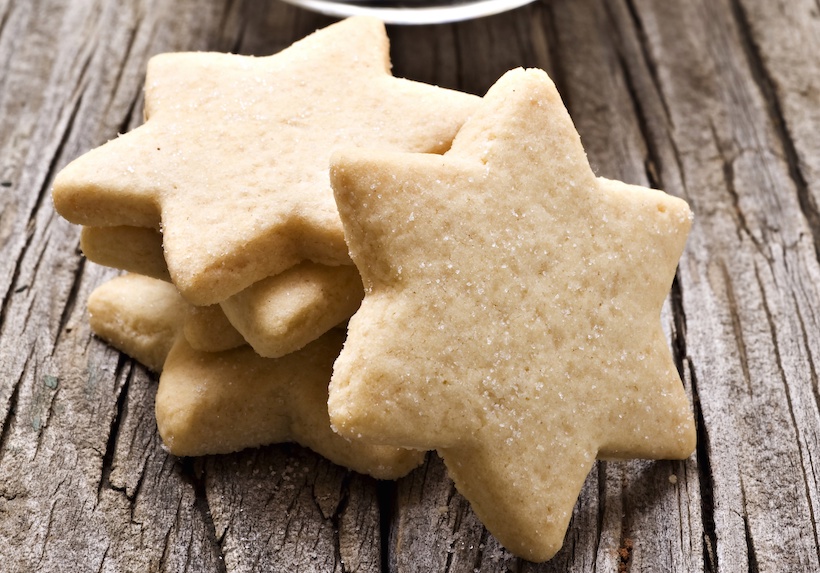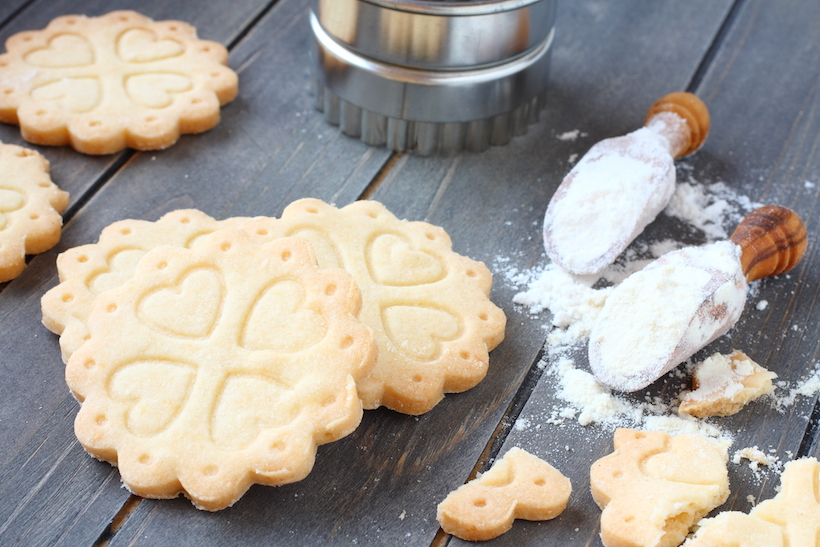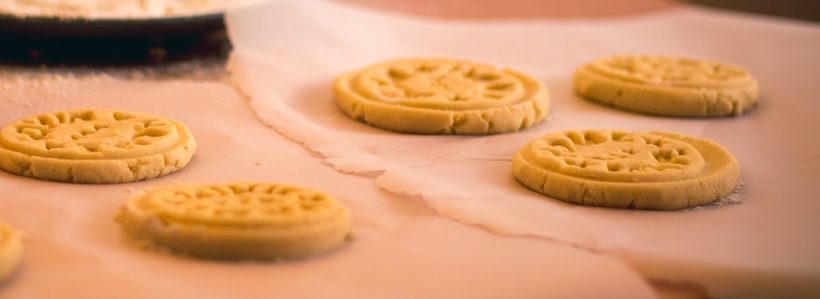I've always been happy when people break out the shortbread cookies around the holidays.
Sweet? Crumbly? Pairs well with everything? Sign me up.
But – ask me the story behind shortbread? Until now, crickets.
I decided I needed to look into the matter; today, let's talk about shortbread's origin and history.

Here's the short of it: shortbread is a traditional biscuit or cookie that hails from medieval Scotland. Its distant ancestor was probably the infamous "twice-baked" medieval biscuit, also called rusk – a sweetened bread roll that was baked and dried in the oven until it hardened.
Shortbread has formed an inseparable part of Scottish celebrations such as Christmas, Hogmanay (the last day of the year celebration), and even wedding ceremonies.
In medieval times, the word "short" applied to crisp, crumbly things. In the 17th century, this term began to include baked goods such as bread, cakes, and biscuits rich in fat such as shortening or butter.
It's interesting to note that shortening actually does what its name implies – it interferes with the formation of gluten strands in pastries. It makes the strands shorter, contributing to the tender, crumbly texture.
A Scottish woman, Mrs. McLintock, takes credit for the first printed shortbread recipe, which appeared in a cookbook in 1736. However, shortbread had become a holiday staple long before that – probably since the 12th century. Mary Stuart, the 16th century Queen of Scots, was famously fond of shortbread and contributed to the beloved pastry's elevation in status.
Today, basic shortbread recipes call for three parts white wheat flour, two parts butter, and one part white sugar. Some bakers alter the classic version by adding corn or rice flour, salt, or 'icing sugar' (powdered sugar in the US). Modern shortbread does not contain leavening agents such as baking powder or soda.
However, the standard ingredients have changed throughout the long history of shortbread. For example, early shortbread recipes often included yeast. Over time, butter replaced yeast, making the pastry more expensive... and reserved for special occasions.
Are you making your own? Because the texture of shortbread doesn't benefit from the formation of gluten strands, it's important not to over-handle the dough. Expert bakers warn to work shortbread dough just enough to make it pliable. It's also recommended to let the dough chill before shaping the biscuits.
For a biscuit with such basic ingredients, shortbread includes a surprising number of regional varieties. For example, shortbread baked in Goosnargh, Lancashire, traditionally contains coriander and caraway seeds. Some Scottish recipes call for almonds and orange peel, while others flavor shortbread with ginger.
The pastry also comes in different shapes. Shortbread is often baked in circular molds with a traditional design reminiscent of the ancient Yule bannock – a round cake calling to mind the distinct pre-Christian roots of sun worship. Other common shortbread shapes are fingers, squares, or bell-shaped wedges known as petticoat tails.

As mentioned before, today's melt-in-your-mouth shortbread likely originated from dry, hard medieval biscuits. Those were made from humble leftover dough scraps that frugal bakers didn't want to waste.
Here's an interesting piece of linguistics: the word "biscuit" sprang from the Latin "bis coctus," literally "twice-cooked." This definition refers to the British flat, dry, and crisp biscuit – not the American soft, fluffy quick bread somewhat resembling the British scone. As implied here, biscuits first were baked and then left in the oven to dry on slow heat.
Originally, medieval hard biscuits were made from bread dough, which contained yeast and little to no fat. It is hard to pinpoint the exact time in the history of shortbread when bakers stopped using yeast and began adding copious amounts of butter (a comparatively expensive product) to the dough instead.
The 16th century was an economically challenging one for Scotland, with inflation, harvest failures, and plague outbreaks. In the 17th century, however, Scotland's economy rallied. The Scots gained access to the English markets.
Land use became more effective, enabling farmers to raise more cattle and obtain more milk and butter. The growing economy and more widespread use of butter probably gave rise to the Scottish shortbread as we know it today.
At the court of Mary Stuart, shortbread was no longer a pastry for the commoners. It rose in rank to become a luxury treat reserved for special occasions... and the tables of rich people.
Mary, Queen of Scots, spent most of her childhood in France. Her French tastes influenced her shortbread preferences. She loved the "petites galettes," thin French biscuits made with large quantities of butter and containing flavorful caraway seeds – a description reminiscent of modern shortbread.
By 1736, when Mrs. McLintock's famous first printed recipe of shortbread was published, shortbread had already long been a popular treat.
Other recipes of that era diversified any 'normal' shortbread flavor with various ingredients. For example, a recipe by an 18th-century cook named Mrs. Frazer calls for citron, orange peel, and almonds.
The shortbread recipe in The Complete Biscuit and Gingerbread Baker's Assistant, the 1854 book by George Read, calls for equal proportions of sugar and butter. It also includes eggs – an ingredient that adds tenderness but reduces the crumbliness we associate with shortbread. George Read's pastry wouldn't be called shortbread under today's definition.
Eventually, the proportions of one part sugar, two parts butter, and three parts flour became more or less canonical, while yeast and eggs disappeared from shortbread recipes altogether.
Today, Her Majesty Queen Elizabeth II's favorite shortbread recipe calls for powdered sugar and corn flour for an extra crumbly texture. It also includes flavor-enhancing salt and vanilla paste.
Shortbread is inexorably linked to Scottish celebrations. We all know Christmas, but what exactly are Yuletide and Hogmanay?
Yuletide, or Yule, derives from the Germanic word "jól" – it's a holiday celebrating the midwinter Wild Hunt of the Norse god Odin. It arrived in Scotland with the Viking invaders in the 8th and 9th centuries. As Christianity made its way north, Yule blended into Christmas – and some would say Odin transformed into the jolly Father Christmas of today. (And you'll probably recognize the yule log).
During the Protestant Reformation, many religious authorities proclaimed Christmas an ungodly Popish festival and forbade celebrating it. (A similar fate befell the mince pie).
For a shockingly long time, the ban endured in Scotland – from the end of the 17th century to the mid-20th. Thus, until the 1950s, many Scots had their big winter solstice festival not on December 25th but Hogmanay – Scottish New Year's Eve.
That's great, but what does this have to do with shortbread? An old Scottish New Year tradition is called "first foot." The custom states that the first person to cross a house's threshold in the new year should be a dark-haired man carrying coal, salt, a black bun (a pastry-covered fruitcake), a dram of whisky, and shortbread. The shortbread traditionally had a round shape, symbolizing the elusive winter sun.
Shortbread also forms a part of Scottish wedding customs. It became a tradition to serve shortbread at weddings to demonstrate the couple's prosperity. Back in the days when butter and sugar were expensive, only a well-off couple could afford to serve this delicious treat to their wedding guests.

Shortbread made its way from Scotland to the rest of the United Kingdom, Ireland, and all over the commonwealth.
Many home bakers in the UK make shortbread in their kitchens, but several popular commercial brands also exist.
Possibly the best-known brand nowadays is Walkers Shortbread. The Scottish company's history of shortbread making dates back to 1898!
Shortcake, shortbread's cousin, is sometimes made using vegetable fat rather than butter. Unlike shortbread, shortcake recipes usually include a leavening agent such as baking powder, and often eggs as well. Shortcake is typically sweeter than shortbread and is often served with toppings like whipped cream and strawberries.
Today, there's no need to limit your shortbread enjoyment to special occasions (or even seasons!). Shortbread has become a classic teatime treat and goes wonderfully with a steaming cup of Earl Grey tea.
Whether round, rectangular, or bell-shaped, shortbread never fails to gratify with its tender, crumbly texture and mild sweetness.
And there's no need to stick to the base recipe, either. Some creative bakers replace part of the flour with cocoa for chocolate shortbread, enrich the pastry with citrus zest, dried fruit, or nuts, dip their shortbread in melted chocolate, or make savory shortbread with herbs or grated cheese.
In the remote Scottish islands of Shetland, one wedding custom was breaking shortbread over the new bride's head before she entered her first home. This was considered a token of prosperity and good luck.
While modern brides would likely not agree to include shortbread crumbs in their hair, many Shetland weddings do include shortbread gifts or themes to this day.
So there you have it – shortbread has quite the long history. Popularized by royalty, this seasonal biscuit really marks the season, so to speak.
So whether you're celebrating Hogmanay, Christmas, or something else – enjoy your shortbread!